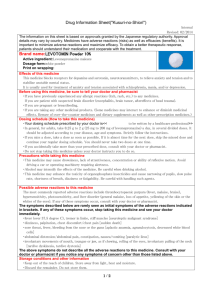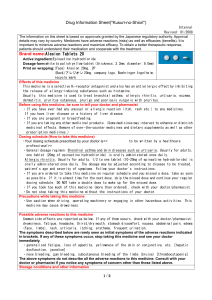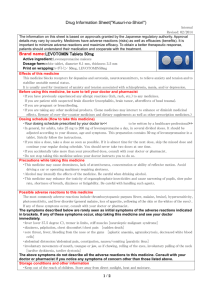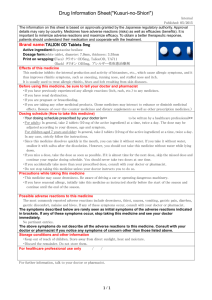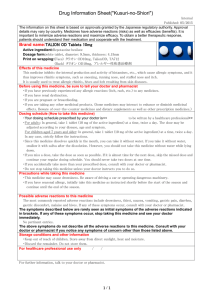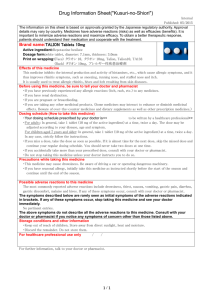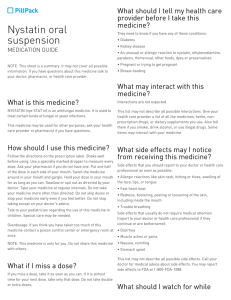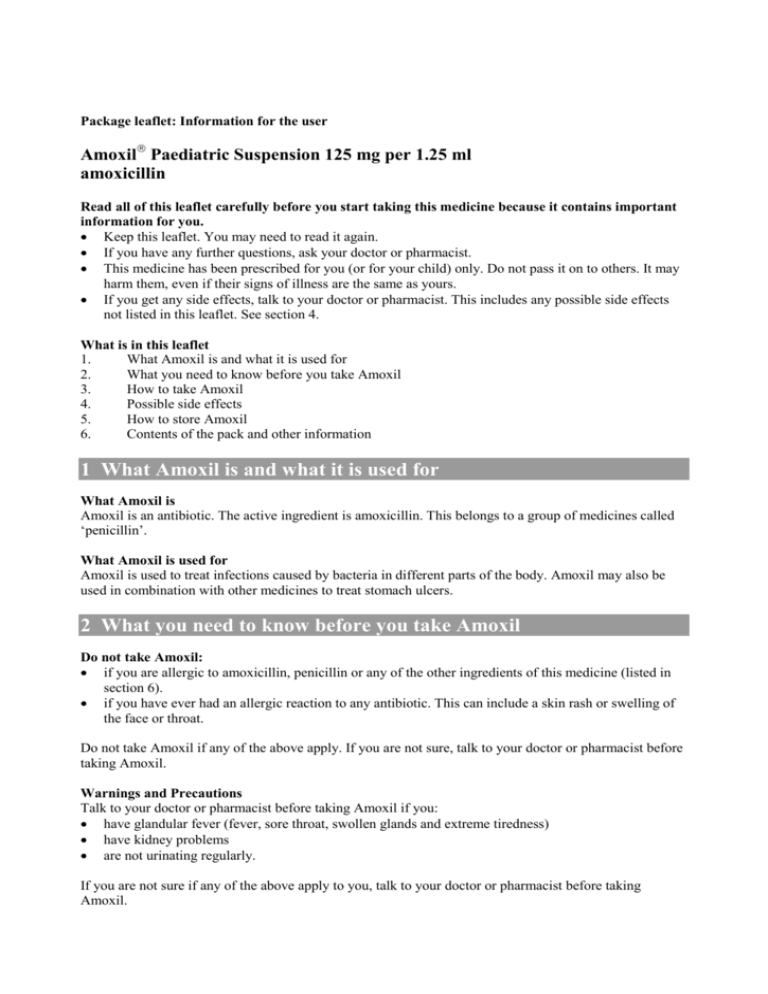
Package leaflet: Information for the user
Amoxil Paediatric Suspension 125 mg per 1.25 ml
amoxicillin
Read all of this leaflet carefully before you start taking this medicine because it contains important
information for you.
• Keep this leaflet. You may need to read it again.
• If you have any further questions, ask your doctor or pharmacist.
• This medicine has been prescribed for you (or for your child) only. Do not pass it on to others. It may
harm them, even if their signs of illness are the same as yours.
• If you get any side effects, talk to your doctor or pharmacist. This includes any possible side effects
not listed in this leaflet. See section 4.
What is in this leaflet
1.
What Amoxil is and what it is used for
2.
What you need to know before you take Amoxil
3.
How to take Amoxil
4.
Possible side effects
5.
How to store Amoxil
6.
Contents of the pack and other information
1 What Amoxil is and what it is used for
What Amoxil is
Amoxil is an antibiotic. The active ingredient is amoxicillin. This belongs to a group of medicines called
‘penicillin’.
What Amoxil is used for
Amoxil is used to treat infections caused by bacteria in different parts of the body. Amoxil may also be
used in combination with other medicines to treat stomach ulcers.
2 What you need to know before you take Amoxil
Do not take Amoxil:
• if you are allergic to amoxicillin, penicillin or any of the other ingredients of this medicine (listed in
section 6).
• if you have ever had an allergic reaction to any antibiotic. This can include a skin rash or swelling of
the face or throat.
Do not take Amoxil if any of the above apply. If you are not sure, talk to your doctor or pharmacist before
taking Amoxil.
Warnings and Precautions
Talk to your doctor or pharmacist before taking Amoxil if you:
• have glandular fever (fever, sore throat, swollen glands and extreme tiredness)
• have kidney problems
• are not urinating regularly.
If you are not sure if any of the above apply to you, talk to your doctor or pharmacist before taking
Amoxil.
Blood and urine tests
If you are having:
• Urine tests (glucose) or blood tests for liver function
• Oestriol tests (used during pregnancy to check the baby is developing normally)
Tell your doctor or pharmacist that you are taking Amoxil. This is because Amoxil can affect the results of
these tests.
Other medicines and Amoxil
Tell your doctor or pharmacist if you are taking, have recently taken or might take any other medicines.
•
•
•
•
•
If you are taking allopurinol (used for gout) with Amoxil, it may be more likely that you will have an
allergic skin reaction.
If you are taking probenecid (used for gout), your doctor may decide to adjust your dose of Amoxil.
If you are taking medicines to help stop blood clots (such as warfarin), you may need extra blood tests.
If you are taking other antibiotics (such as tetracycline) Amoxil may be less effective.
If you are taking methotrexate (used for the treatment of cancer and severe psoriasis) Amoxil may
cause an increase in side effects.
Pregnancy and breast-feeding
If you are pregnant or breast-feeding, think you may be pregnant or are planning to have a baby, ask your
doctor or pharmacist for advice before taking this medicine.
Driving and using machines
Amoxil can have side effects and the symptoms (such as allergic reactions, dizziness and convulsions)
may make you unfit to drive.
Do not drive or operate machinery unless you are feeling well.
Amoxil contains aspartame, maltodextrin and sodium benzoate
• Aspartame (E951) is a source of phenylalanine. This may be harmful for patients with a condition
called ’phenylketonuria’.
• Maltodextrin is absorbed as glucose. If you have been told by your doctor that you have an intolerance
to some sugars, contact your doctor before taking this medicinal product.
• Sodium benzoate (E211) is a mild irritant to the eyes, skin and mucous membrane and can cause an
increased risk of jaundice in new born babies.
3 How to take Amoxil
Always take this medicine exactly as your doctor or pharmacist has told you. Check with your doctor or
pharmacist if you are not sure.
•
•
Shake bottle well before each dose.
Space the doses evenly during the day, at least 4 hours apart
The usual dose is:
Children weighing less than 40 kg
All doses are worked out depending on the child’s body weight in kilograms.
• Your doctor will advise you how much Amoxil you should give to your baby or child.
• The usual dose is 40 mg to 90 mg for each kilogram of body weight a day given in two or three
divided doses.
• The maximum recommended dose is 100 mg for each kilogram of body weight a day.
Adults, elderly patients and children weighing 40 kg or more
This suspension is not usually prescribed for adults and children weighing more than 40 kg. Ask your
doctor or pharmacist for advice.
Kidney problems
If you have kidney problems the dose might be lower than the usual dose.
If you take more Amoxil than you should
If you have taken too much Amoxil, signs might be an upset stomach (feeling sick, being sick or
diarrhoea) or crystals in the urine, which may be seen as cloudy urine, or problems urinating. Talk to your
doctor as soon as possible. Take the medicine to show the doctor.
If you forget to take Amoxil
• If you forget to take a dose, take it as soon as you remember.
• Do not take the next dose too soon, wait about 4 hours before taking the next dose.
• Do not take a double dose to make up for a forgotten dose.
How long should you take Amoxil for?
• Keep taking Amoxil for as long as your doctor has told you to, even if you feel better. You need every
dose to help fight the infection. If some bacteria survive they can cause the infection to come back.
• Once you finish treatment, if you still feel unwell you should go back to see the doctor.
Thrush (a yeast infection of moist areas of the body which can cause soreness, itching and white
discharge) may develop if Amoxil is used for a long time. If this occurs tell your doctor.
If you take Amoxil for a long time, your doctor may perform additional tests to check your kidneys, liver
and blood are working normally.
If you have any further questions on the use of this medicine, ask your doctor or pharmacist.
4 Possible side effects
Like all medicines, this medicine can cause side effects, although not everybody gets them.
Stop taking Amoxil and see a doctor straight away, if you notice any of the following serious side
effects – you may need urgent medical treatment:
The following are very rare (may affect up to 1 in 10,000 people)
•
•
•
•
•
•
allergic reactions, the signs may include: skin itching or rash, swelling of the face, lips, tongue, body
or breathing difficulties. These can be serious and occasionally deaths have occurred
rash or pinpoint flat red round spots under the skin surface or bruising of the skin. This is due to
inflammation of blood vessel walls due to an allergic reaction. It can be associated with joint pain
(arthritis) and kidney problems
a delayed allergic reaction can occur usually 7 to 12 days after having Amoxil, some signs include:
rashes, fever, joint pains and enlargement of the lymph nodes especially under the arms
a skin reaction known as ‘erythema multiforme’ where you may develop: itchy reddish purple patches
on the skin especially on the palms of the hands or soles of the feet, ‘hive-like’ raised swollen areas on
the skin, tender areas on the surfaces of the mouth, eyes and genitals. You may have a fever and be
very tired
other severe skin reactions can include: changes in skin colour, bumps under the skin, blistering,
pustules, peeling, redness, pain, itching, scaling. These may be associated with fever, headaches and
body aches
fever, chills, a sore throat or other signs of an infection, or if you bruise easily. These may be signs of
a problem with your blood cells
•
the Jarisch-Herxheimer reaction which occurs during treatment with Amoxil for Lyme disease and
causes fever, chills, headache, muscle pain and skin rash.
• inflammation of the large bowel (colon) with diarrhoea (sometimes containing blood), pain and fever
• serious liver side effects may occur. They are mainly associated with people having treatment over a
long period, males and the elderly. You must tell your doctor urgently if you get:
o severe diarrhoea with bleeding
o blisters, redness or bruising of the skin
o darker urine or paler stools
o yellowing of the skin or the whites of the eyes (jaundice). See also anaemia below which
might result in jaundice.
These can happen when having the medicine or for up to several weeks after.
If any of the above happens stop taking the medicine and see your doctor straight away.
Sometimes you may get less severe skin reactions such as:
• a mildly itchy rash (round, pink-red patches), ‘hive-like’ swollen areas on forearms, legs, palms, hands
or feet. This is uncommon (may affect up to 1 in 100 people).
If you have any of these talk to your doctor as Amoxil will need to be stopped.
The other possible side effects are:
Common (may affect up to 1 in 10 people)
•
skin rash
•
feeling sick (nausea)
•
diarrhoea.
Uncommon (may affect up to 1 in 100 people)
•
being sick (vomiting).
Very rare (may affect up to 1 in 10,000 people)
•
thrush (a yeast infection of the vagina, mouth or skin folds), you can get treatment for thrush from
your doctor or pharmacist
•
kidney problems
•
fits (convulsions), seen in patients on high doses or with kidney problems
•
dizziness
•
hyperactivity
•
crystals in the urine, which may be seen as cloudy urine, or difficulty or discomfort in passing urine.
Make sure you drink plenty of fluids to reduce the chance of these symptoms
•
teeth may appear stained, usually returning to normal with brushing (this has been reported in
children)
•
the tongue may change to yellow, brown or black and it may have a hairy appearance
•
an excessive breakdown of red blood cells causing a type of anaemia. Signs include: tiredness,
headaches, shortness of breath, dizziness, looking pale and yellowing of the skin and the whites of
the eyes
•
low number of white blood cells
•
low number of cells involved with blood clotting
•
the blood may take longer to clot than it normally would. You may notice this if you have a
nosebleed or cut yourself.
Reporting of side effects
If you get any side effects, talk to your doctor or pharmacist. This includes any possible side effects not
listed in this leaflet. You can also report side effects directly via the Yellow Card Scheme at:
www.mhra.gov.uk/yellowcard.
By reporting side effects you can help provide more information on the safety of this medicine.
5 How to store Amoxil
•
•
•
•
•
•
Keep this medicine out of the sight and reach of children.
Do not use this medicine after the expiry date which is stated on the carton. The expiry date refers to
the last day of that month.
Dry powder: Do not store above 25oC.
Liquid suspension: Do not store above 25oC. Once made up, the suspension should be used within 14
days.
Do not use this medicine if there are visible signs of deterioration.
Do not throw away any medicines via wastewater or household waste. Ask your pharmacist how to
throw away medicines you no longer use. These measures will help protect the environment.
6 Contents of the pack and other information
What Amoxil contains
• The active substance in each suspension is 125 mg amoxicillin.
• The other ingredients are: Carboxymethylcellulose Sodium 12, Lemon-Peach-Strawberry Dry
Flavour, Crospovidone, Aspartame (E951), Sodium Benzoate (E211), Xanthan Gum (E415), Silica
Hydrophobic Colloidal Magnesium Stearate.
What Amoxil looks like and contents of the pack
Amoxil 125 mg/1.25 ml Powder for Oral Suspension is a white powder with yellowish grains filled into
clear glass bottles with a nominal volume of 45 ml (for a 20 ml presentation). The bottles are packaged in
a carton with a dosing syringe.
Not all pack sizes may be marketed.
Marketing authorisation holder and manufacturer
Marketing Authorisation Holder: Beecham Group plc, Stockley Park West, Uxbridge, Middlesex UB11
1BT
Manufacturer: Glaxo Wellcome Production, Z.I. de la Peyenniere, 53100 Mayenne, France
Other formats
To listen to or request a copy of this leaflet in Braille, large print or audio please call, free of charge:
0800 198 5000 (UK Only)
Please be ready to give the following information:
Product name Amoxil Paediatric Suspension
Reference number
00038/0107
This is a service provided by the Royal National Institute of Blind People.
This leaflet was last revised in September 2015.
Amoxil is a registered trade mark of the GSK group of companies.
© 2015 GSK group of companies. All rights reserved.
General advice regarding the use of antibiotics
Antibiotics are used to treat infections caused by bacteria. They have no effect against infections
caused by viruses.
Sometimes an infection caused by bacteria does not respond to a course of an antibiotic. One of the
commonest reasons for this to occur is because the bacteria causing the infection are resistant to the
antibiotic that is being taken. This means that they can survive and even multiply despite the
antibiotic.
Bacteria can become resistant to antibiotics for many reasons. Using antibiotics carefully can help
to reduce the chance of bacteria becoming resistant to them.
When your doctor prescribes a course of an antibiotic it is intended to treat only your current
illness. Paying attention to the following advice will help prevent the emergence of resistant
bacteria that could stop the antibiotic working.
1.
2.
3.
4.
5.
It is very important that you take the antibiotic at the right dose, at the right times and for the
right number of days. Read the instructions on the label and if you do not understand
anything ask your doctor or pharmacist to explain.
You should not take an antibiotic unless it has been prescribed specifically for you and you
should use it only to treat the infection for which it was prescribed.
You should not take antibiotics that have been prescribed for other people even if they had
an infection that was similar to yours.
You should not give antibiotics that were prescribed for you to other people.
If you have any antibiotic left over when you have taken the course as directed by your
doctor you should take the remainder to a pharmacy for appropriate disposal.
--------------------------------------------------------------------------------------------------------------------------Instructions for reconstitution
Check cap seal is intact before use.
Invert and shake bottle to loosen powder.
Fill the bottle with water to just below the mark on the bottle label.
Invert and shake well, then top up with water to the mark. Invert and shake again
Shake well before taking each dose.


